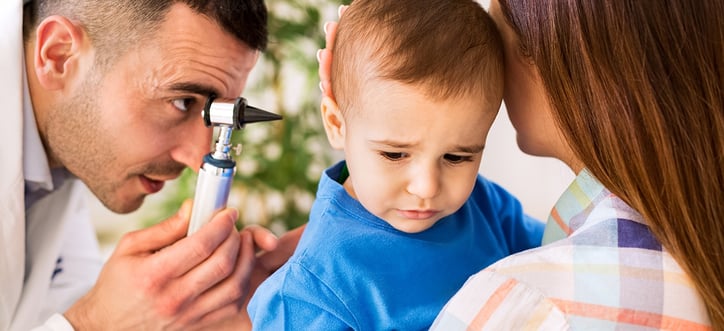 Ear infections are very common among children. Almost 16 million kids will visit a doctor each year with an ear infection and more than 80 percent of all kids will be diagnosed with at least one middle-ear infection before they are three-years old. It is important to know how to recognize ear infection symptoms, especially in infants and young children who may not be able to tell you what they are feeling.
Ear infections are very common among children. Almost 16 million kids will visit a doctor each year with an ear infection and more than 80 percent of all kids will be diagnosed with at least one middle-ear infection before they are three-years old. It is important to know how to recognize ear infection symptoms, especially in infants and young children who may not be able to tell you what they are feeling.Ear Infection Symptoms to Watch For
Infants and toddlers cannot come out and say “Mom, my ear hurts!” so you need to be aware that the following symptoms might be a sign of an ear infection:
- Pulling, rubbing or scratching ear(s)
- Fever of 100F or higher
- Loss of appetite
- Irritability
- Crying
- Difficulty sleeping
- Fluid draining from ear
- Difficulty hearing your voice or reacting to noises
With children, teens, or adults who are better able to tell you what symptoms they might be feeling, the following symptoms may indicate the possibility of an ear infection:
- Pain in the ear(s) that may be worse when lying down
- Pressure or feeling of fullness in ear
- Fever of 100F or higher
- Loss of appetite
- Nausea and/or vomiting
- Headache
- Dizziness
- Loss of balance
- Fluid draining from ear
- Difficulty hearing
When to Call the Doctor
If you observe or are told about any of the above ear infection symptoms, it might be time to consult with your physician. He or she may suggest taking a “wait and see” approach because symptoms will often start to improve over 24 hours. However, if there is severe pain or symptoms worsen, prompt medical care is needed.
Ear infection symptoms can be a sign of other conditions, including infected tonsils or adenoids. In more severe cases of ear infections, the infection could potentially spread to other structures in your child’s head, including the mastoid.
How a Doctor Determines if an Ear Infection is Present
The doctor will examine the ears with an otoscope to look for ear infection symptoms within the inside of the ear. He or she will look for:
- Redness in the ear
- Appearance of fluid behind the eardrum
- Movement of the eardrum
These are often the most obvious signs of an ear infection.
Additionally, the doctor might also perform tests, including an audiogram to see if hearing loss has occurred or a tympanogram to measure air pressure within the middle ear to determine if the Eustachian tube is working properly.
Treating an Ear Infection
The doctor may prescribe antibiotics to fight an ear infection, especially if it is bacterial in nature. If the underlying cause of the ear infection was because of allergies or a cold, he or she might also prescribe an antihistamine and/or decongestant.
To reduce fever or pain, the doctor may recommend over-the-counter ibuprofen or acetaminophen. He or she might also prescribe anesthetic eardrops to ease the pain in the ear(s).
For chronic ear infections or suspected hearing loss, your child’s pediatrician may recommend seeing an ENT specialist to rule out or address ear infection causing conditions such as infected tonsils and adenoids. Chronic ear infections may also indicate the need for ventilation tubes to be inserted in your child’s ears to improve his or her hearing and help prevent additional infections.
Do not ignore ear infection symptoms. It is possible that the ear infection will go away on its own. However, if it doesn’t, this type of infection can be very serious and could potentially lead to hearing loss.






